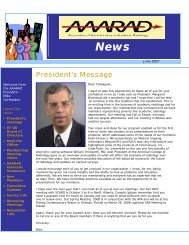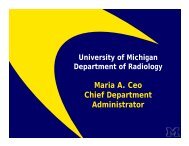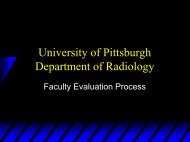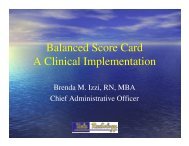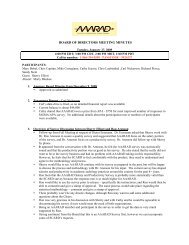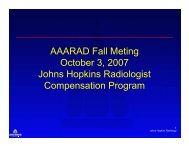Faculty Evaluation Systems - AAARAD
Faculty Evaluation Systems - AAARAD
Faculty Evaluation Systems - AAARAD
Create successful ePaper yourself
Turn your PDF publications into a flip-book with our unique Google optimized e-Paper software.
<strong>Faculty</strong> <strong>Evaluation</strong> <strong>Systems</strong><br />
Julia Kennedy Tussing<br />
Stanford University<br />
September 21, 2000
AAARRO Member Practices<br />
• Surveyed AAARRO email distribution list<br />
• 21 respondents<br />
• Huge variation in practices<br />
– From: no review, no increases, no bonus<br />
– To: full peer committee review, formulaic<br />
bonus plan and extensive data collection.
21 Respondents from:<br />
--Virginia<br />
--Texas<br />
--New Mexico<br />
--Duke<br />
– Washington --Maryland<br />
– Davis --Yale<br />
– Johns Hopkins -- Missouri<br />
– SUNY at Stonybrook --UCSF<br />
– Med Univ of South Carolina --St Louis U<br />
– Michigan State --Miami<br />
– Wisconsin --Harvard<br />
– Medical College of Wisc --Iowa<br />
– Stanford
Review of Common Practices<br />
• No system, salary increases are formulaic<br />
(seniority or other criteria) (2)<br />
• Chair discretion, no formal process (3)<br />
• Formal process with fairly standardized<br />
information gathered, culminating in<br />
Section Chief or Chair meeting (14)<br />
• Formal process with standardized<br />
information gathered and evaluated by peer<br />
group (2)
Criteria<br />
• Almost all use clinical productivity,<br />
research productivity, and teaching quality<br />
or effort in the review.<br />
• Half use some measure of administrative<br />
effort or “citizenship”.<br />
• Half use some kind of point system to<br />
quantify conversion of activity to amount of<br />
base or bonus.<br />
• Only 6 used any goal-setting in the review<br />
process.
Base vs. Bonus<br />
• 11 of the respondents had a bonus plan. All<br />
but one were based on individual rather than<br />
group performance.<br />
• 3 respondents had no flexibility in base<br />
salary, and used the review system solely to<br />
set a bonus.
School: Stanford 21 respondents<br />
Degree of Structure High 2 zero, 8 low, 5 medium, 6 high<br />
Performed by:<br />
Ad Hoc Committee scores;<br />
Chair sets salary/ bonus.<br />
2 no review; 2 formula driven; 6 both Chair and<br />
Chief or committee; 11 chair.<br />
<strong>Faculty</strong> Self-Assessment Yes.<br />
4 self-assessments, 17 none<br />
Documentation<br />
reviewed:<br />
Teaching evaluations by residents, etc. 18 use teaching as a criterion<br />
Research Self-evaluation, numbers 19 us research as a criterion<br />
Patient Care RVUs & evaluations 17 use clinical productivity as a criterion<br />
Administration X 12 use administration as a criterion<br />
Goal-setting<br />
Yes<br />
Point system For bonus salary & bonus, ad hoc<br />
or salary<br />
committee score.<br />
Bonus plan Yes; 1% to 30% of base salary. 12 have bonus plans<br />
4 use formal goal-setting, 2 informal, 15 not at<br />
all<br />
9 use points for base, bonus or both; 11 do<br />
not use any point system.<br />
Range of salary<br />
increases: 0% to 14%<br />
Description:<br />
Assemble folders with info on all<br />
subjects; reviewed & scored by<br />
Ad Hoc Committee; Chair sets<br />
salary & bonus based on scores<br />
& intangibles. Bonus is partly<br />
algorithmic.
<strong>Faculty</strong> <strong>Evaluation</strong>s at Stanford<br />
• In 1989, the current Chair joined the<br />
department, and began to build the current<br />
system. Each year, additions or refinements<br />
were made as it evolved.<br />
• In 1998, the School of Medicine mandated a<br />
written plan for each department for both<br />
the evaluation and the bonus.
Stanford Review Process<br />
• Assemble information into faculty folders<br />
• Convene Ad Hoc Committee to review<br />
folders<br />
• Process Ad Hoc Committee Scores<br />
• Run bonus algorithm<br />
• Chair reviews scores and folder, sets bonus<br />
and salary<br />
• Chair meets with each faculty member,<br />
reviews performance and sets goals for next<br />
period
<strong>Faculty</strong> Folders<br />
• Section Chief evaluation<br />
• “Performance Profile” giving goals for the<br />
period and observations on how well they<br />
were met<br />
• Self-assessment of activity in research,<br />
teaching, and patient care in a standardized<br />
“Activity Report”<br />
• RVUs (rank in dept & section)
Folders, con’t.<br />
• Resident, Fellow and clerkship teaching<br />
evaluations<br />
• <strong>Evaluation</strong>s from students, post-docs and<br />
graduate students (for research faculty)<br />
• Attendance and participation in medical<br />
school course (301A)<br />
• Attendance at <strong>Faculty</strong> meetings
DR. XAVIER WRAY<br />
MCL Line, Full Professor, 10 years in Department<br />
Performance Profile Date: 11/15/98<br />
Signatures:<br />
Chair_____________________<br />
<strong>Faculty</strong>_____________________<br />
Clinical<br />
Capability X Goals Measurement<br />
Observations<br />
Reputation<br />
Productivity<br />
• Acknowledged inside and<br />
outside of SUSOM as an<br />
expert in specific area of<br />
medicine<br />
• Building practice<br />
# Invited<br />
Major<br />
Presentation<br />
s<br />
10%<br />
Increase in<br />
RVUs<br />
4 Invitations: 1)<br />
2)….3)…..4)<br />
RVUs increased 9% from<br />
previous fiscal year, from<br />
3000 to 3270.
Ad Hoc Committee<br />
• 5 member committee reviews every folder<br />
and scores each faculty member from 1 to 5<br />
in the following categories:<br />
– Patient Care<br />
– Teaching<br />
– Research<br />
– Administration<br />
– Overall value to the Department
Scoring<br />
• Ad Hoc scores are averaged for each<br />
category and faculty are ranked according<br />
to “Overall” scores<br />
• Current scores are compared to the previous<br />
year for improvement or decline; a 5-year<br />
history is provided to the Chair<br />
• Bonus algorithm run using Ad Hoc scores
Chair Review<br />
• Add “Report Card” to folder for Chair<br />
review<br />
• Chair sets salaries based on folder, scores<br />
and personal knowledge of performance<br />
• Administrator runs bonus algorithm and<br />
Chair sets discretionary bonus<br />
• Chair meets with each of 43 faculty<br />
members to review performance, set goals
NAME:<br />
DEPARTMENT OF RADIOLOGY<br />
FACULTY REPORT CARD<br />
Comp Teaching RVUs Research<br />
Section<br />
Chief Eval:<br />
Ad Hoc<br />
Scores<br />
FY '98 FY '99<br />
%<br />
Increase FY '00<br />
%<br />
Increase FY '01<br />
%<br />
Increase<br />
Total Publications<br />
Senior Author Pubs<br />
Total Abstracts<br />
Senior Author abstracts<br />
RVUs (adj by clinical time) 4113 5808 41.21% -100.00%<br />
RVU rank 2<br />
Score: Clerkship 4 3.71 -7.25% -100.00%<br />
Rank: Clerkship 27 of 29<br />
Score: Resident 4.75 4.69 -1.26% -100.00%<br />
Score: Fellow 4.58 5 9.17% -100.00%<br />
Rank: Res/Fellow 9 of 39<br />
Research 4.5<br />
Patient Care 4<br />
Teaching 4.5<br />
Administration<br />
Overall 4<br />
Research 2.6 3.89 49.62% 4.01 3.08% -100.00%<br />
Patient Care 4.18 4.48 7.18% 4.35 -2.90% -100.00%<br />
Teaching 4.3 4.37 1.63% 4.41 0.92% -100.00%<br />
Overall 3.73 4.08 9.38% 4.13 1.23% -100.00%<br />
Percentile 0.26 0.49 88.46% 0.30 -38.78% -100.00%<br />
<strong>Faculty</strong> meeting attendance 2 of 8 25.00%<br />
Section Chief attendance<br />
Base + Variable 105000 108675 3.50% 120000 10.42% -100.00%<br />
Bonus 20000 30000 50.00% -100.00% #DIV/0!<br />
TOTAL 125000 138675 10.94% 120000 -13.47% 0 -100.00%
Cons<br />
• Very time-consuming administratively:<br />
– Folders, Number crunching, Report cards,<br />
Tracking performance profiles<br />
• Makeup of Ad Hoc Committee can<br />
influence scoring<br />
• Chair required to meet with 43 faculty<br />
• No formal method of tying evaluation to<br />
compensation (except for bonus algorithm)
Pros<br />
• Excellent historical data on performance<br />
• Use of Committee ensures fairness, multiple<br />
opinions<br />
• Process understood by faculty<br />
• Goal setting ties departmental mission to<br />
performance<br />
• Scoring method gives numerical result
Other Considerations<br />
• The rigor with which you pursue<br />
evaluations must depend upon:<br />
– Administrative resources<br />
– Chair commitment<br />
– <strong>Faculty</strong> involvement<br />
– Cultural limitations



